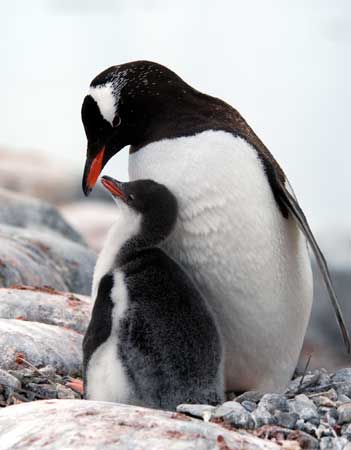
03 March 2007 | Position 55 49.5'S 67 30.7'W
01 March 2007 | Position 58 34'S 67 00'W
24 February 2007 | Position 64 19.5'S 62 55'W
22 February 2007 | Position 64 54'S 62 52'W
20 February 2007 | Position 64 49'S 63 30'W
20 February 2007 | Position 64 49'S 63 30'W
18 February 2007 | Position 65 06'S 64 04'W
16 February 2007 | Position 65 06'S 64 04'W
14 February 2007 | Position 65 26'S 65 22'W
11 February 2007 | Position 66 02'S 65 24'W
09 February 2007 | Position 66 02'S 65 24'W
06 February 2007 | Position 66 52'S 66 47'W
05 February 2007 | Position 66 02'S 65 24'W
04 February 2007 | Position 66 02'S 65 24'W
02 February 2007 | Position 65 08'S 64 02'W
28 January 2007 | Position 64 49'S 63 30'W
26 January 2007 | Position 64 49'S 63 30'W
25 January 2007 | Position 64 32'S 62 00'W
25 January 2007 | Position 64 32'S 62 00'W
24 January 2007 | Position 64 32'S 62 00'W
Gentoo Rookery
28 January 2007 | Position 64 49'S 63 30'W

Persistent NE winds in the last few days have brought the type of weather more typical of the Antarctic - low grey clouds have hidden the mountains and brought frequent rain and snow showers. The breeze has also pushed a lot of ice down the Neumayer Channel which is now clogging the bay outside the narrow entrance to Dorian Bay, but only the occasional bergy bit finds its way into our protected inner harbour. Ignoring the weather, we have spent many hours ashore amongst the Gentoo penguins watching their behaviour and the workings of a busy colony. They seem quite different characters to the Chinstraps we have seen so far and their chicks are beautiful, with grey and white down and bright orange bills rather than the uniform grey of the Chinstraps. Most of the chicks are well grown and can be left alone for long periods while the adults go foraging at sea, but we did find one much smaller chick with a parent in constant attendance (see photo) Their feeding behaviour with the older chicks is quite something to watch. A returning parent identifies its own chicks with calls and they peck and cry in eager anticipation. The adult then sets off at a brisk pace, waddling through the colony and hopping up and down rocks with the chicks in hot pursuit. The high speed chase often causes all sorts of chaos amongst the neighbours and is so frantic that the birds often slip and fall along the way. It usually ends on the edge of the colony when the parent stops and feeds the first chick to arrive and research suggests it might be a way of separating the weaker chick from the stronger. We also spent time watching the penguins in the water. When they first get in they wash vigorously using their feet and flippers to clean off the muck of the colony. In the shallow water of the anchorage we could see them swimming under the boat, suddenly graceful as they 'flew' throught the water in pursuit of krill, a tiny shrimp-like creature that is their main prey...
Comments
| Vessel Name: | Wandering Albatross |
Gallery not available